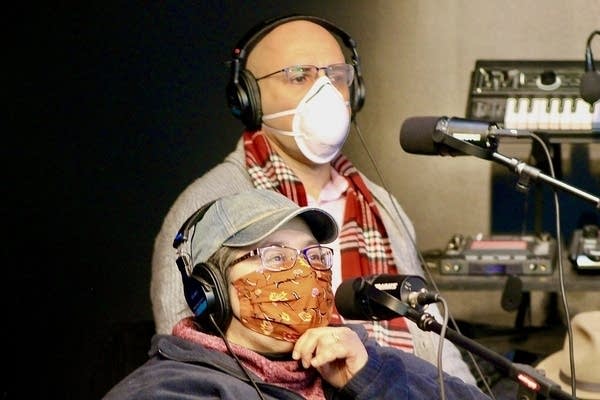New theater production doesn't shy away from taking on serious issues
Teatro del Pueblo's 'Coco's Barrio' addresses immigration and children caged by ICE

Go Deeper.
Create an account or log in to save stories.
Like this?
Thanks for liking this story! We have added it to a list of your favorite stories.
Tackling issues such as immigration or children being separated from their parents at the border and put into cages can be a challenge.
But Teatro del Pueblo’s “Coco’s Barrio” does just that.
Coco’s Barrio began as a live performance show that’s part old-time radio and part Saturday Night Live. But then the pandemic turned everything upside down.
Teatro del Pueblo began looking for ways to keep the show going, said Alberto Justiniano, a director with the theater group. The result was turning Coco’s Barrio into a podcast.
Turn Up Your Support
MPR News helps you turn down the noise and build shared understanding. Turn up your support for this public resource and keep trusted journalism accessible to all.
“It really combines pop culture with social justice issues that are affecting our community, the Latino community. But also, that has a universal message that affects other BIPOC communities as well as groups in the United States,” Justiniano said.
Coco’s Barrio not only tackles issues such as immigration, DREAMers and children being put in cages by U.S. Immigration and Customs Enforcement. But it also introduces Latino community members to a broader audience.
In the world of “Coco’s Barrio,” Silvia Pontaza is Coco. Some people see Coco as the host, Pontaza said. But she sees Coco differently. She is the person who knows everyone in the community, Pontaza said.
“Coco knows people and she gets to interact. I see her as ushering people to my neighborhood to get to know everybody and make them feel welcome,” Pontaza said.
Initially, the troupe wanted to do a light and funny show. But the issues being discussed were not only important to the Latino community — but also political.

“We started to notice that we could not be silent about what’s going on. We realized very quickly that there were things that we needed to say and things that were happening in the previous administration that were outrageous. And why not use our show to say things and make it in a way that makes people think?” Pontaza said.
The shows are done as a parody with a comical take. The performances aren’t just acted out, but they contain a musical element that is woven throughout the theme of the show.
One performance had a Día de los Muertos theme — but with a twist. The souls of departed loved ones looking to come back to visit had to go through immigration. But the required visa was the photo placed on the altar by their living loved ones.
The song that introduces the episode is a parody of “Bad Boys” which takes aim at ICE, with a line saying “whatcha gonna do when we take your kids …,” referring to children being separated from their parents at the southern border by U.S. immigration.
Justiniano quickly pointed out that the “magicians” behind the music and technical aspect are Vladimir Garrido and Barry Madore.
“He (Madore), along with Vladi, creates soundscapes, which are like another script within our storytelling,” Justiniano said.
Abel Piñiero, one of the actor/musicians, said he doesn’t see the shows as being overtly political or partisan.
“What they really tried to do is bring humanity to the situation and the inhumanity and show the struggle that real people are going through,” Piñiero said.
When it comes to shows, everyone has a favorite.
For Cathy Piñiero, who is married to Abel, it’s the Wizard of Oz episode. The episode had Dorothy going to the land of Oz searching for the children who had been put in cages by U.S. immigration — what Cathy Piñiero called tragic.
“It was a way for us to bring it to the attention of people that were unaware. And so that was an important thing for me because not everybody pays attention to news. But we can bring it to someone’s attention. And even though it’s a parody, it’s something that, it’ll still strike you because, you know, kids in cages? It was an important piece,” Cathy Piñiero said.

But aside from the issues, what resonates with many is the theme song. The inspiration for the song came from El Burrito Mercado, Justinano said. And “Coco’s Barrio” began with the song.
“It all came from that song. And that’s sort of allowed us to be OK, let’s be homie and community, but also have the audacity to say our truth and how our community feels. We’re embedded within this community, the good and the bad,” Justiniano said.
Added Pontaza, “We’re opening the door to, you know, connect with us, connect with the people in Minnesota. We talk about the Mississippi, and we talk about El Burrito and then we bring you to what you know.”
Vicki Adame covers Minnesota’s Latino communities for MPR News via Report for America, a national service program that places journalists into local newsrooms to report on undercovered issues and communities.


